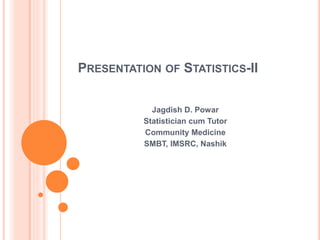
Presentation of statistics
- 1. PRESENTATION OF STATISTICS-II Jagdish D. Powar Statistician cum Tutor Community Medicine SMBT, IMSRC, Nashik
- 2. COMPETENCY-CM6.2 CM6.2 Describe and discuss the principles and demonstrate the methods of collection, classification, analysis, interpretation and presentation of statistical data 2
- 3. LEARNING OBJECTIVES The student should be able to 1. Make presentation of data using different diagrams and graphs according to type of data- Histogram, frequency polygon, Ogive curves, Epidemic curve 2. Interpret the data from diagrams and graphs. 3
- 4. PRESENTATION OF DATA Quantitative Data :- Histogram Frequency polygon Ogive curve Scatter Diagram Epidemic curve 4
- 5. Histogram : Histograms are area diagrams. Area is directly proportional to height (frequency of a class) & width (class interval). In histograms, there will be no space in between rectangular blocks. Data must be tabulated into continuous classes. (i.e. exclusive classes) 5
- 6. CONSTRUCTION OF HISTOGRAM: Consider class intervals along X-axis. Plot corresponding frequencies (i.e. number of observations) on Y- axis. Rectangles are drawn in such a way that area of rectangle is proportional to frequency of a class. 6
- 7. 7 Hemoglobi n 10.0-10.5 10.5-11.0 11.0-11.5 11.5-12.0 12.0-12.5 12.5-13.0 13.0-13.5 13.5-14.0 No.of patients 4 11 14 19 22 16 9 5 Ex-Construct Histogram for given data
- 8. 8
- 9. Frequency polygon: Frequency polygon is an area diagram of frequency distribution developed over a histogram. Construction of frequency polygon: Consider mid-points of classes along X-axis & frequencies along Y-axis. Plot the points corresponding to X-co-ordinate as mid- point & Y-co-ordinate as frequency. Join these points by straight line to get a polygon. 9
- 10. 10
- 11. 4) Cumulative frequency curves (Ogive curves): Since there are two types of cumulative frequencies, we get two types of ogive curves.- a) Less than ogive b) greater than ogive. Construction of ogive curves: Consider upper class limits (lower class limits) along X-axis, & less than frequencies (greater than frequencies) on Y-axis. Plot the points corresponding to X-co-ordinate as upper class limit (lower class limit) & Y-co-ordinate as less than frequency (greater than frequency). Join these points by smooth curve to get a less than (greater than) ogive curve. 11
- 12. Cumulative Frequency distribution Marks frequency Cumulative frequency l.c.f. g.c.f. 0-50 5 5 65 50 - 60 10 15 60 60 - 70 15 30 50 70 – 80 20 50 35 80 - 90 10 60 15 90 – 100 5 65 5 12
- 13. 0 10 20 30 40 50 60 70 50 60 70 80 90 100 Less Than Ogive Curve LCF 13
- 14. 0 10 20 30 40 50 60 70 0 50 60 70 80 90 More than ogive curve GCF 14
- 15. Ogive curves:- 0 10 20 30 40 50 60 70 50 60 70 80 90 100 LOC GOC 15
- 16. Scatter diagram: This is also called as correlation diagram. By using this diagram we can say that whether there is any association or correlation (either positive or negative) between two variables, or they are independent. Only points are plotted on graph paper and depending upon the trend of those points, we get the type of correlation. Uses of this tool: • To understand the behaviour of a process. • To determine if there is a relationship between two factors. • To visually demonstrate the correlation between two related factors. • To determine where there may be a cause and effect relationship. 16
- 17. 145 147 149 151 153 155 157 159 161 163 30 35 40 45 50 55 60 65 70 HeightinCms Weight in kg Scatter Diagram Height (cm) 160 161 154.3 155 158.5 154.3 152.5 150.2 157.8 158 152.5 150.1 157 155.3 152 Weight (in kg) 50.2 51.4 44.4 42.5 47 47.1 43.3 46.5 49.5 52.5 45.3 42.8 50 62 48.7 Ex- Present the data using scatter diagram and comment on it.
- 18. 18
- 19. 19
- 20. Spot Map :- Map showing the geographic location of people with with specific attribute e.g. cases of an infectious disease 20
- 21. 21
- 22. Epidemic curve: Epidemic curve is useful to determine outbreak characteristics like peak of disease occurrence, possible incubation or latency period and type of disease propagation. An epidemic curve is a graphical depiction of the number of cases of illness by the date of illness onset 22
- 23. CONSTRUCTION OF EPIDEMIC CURVE: Take time interval on X-axis Consider number of cases on Y-axis. Plot the points corresponding to X-co-ordinate as time interval & Y-co-ordinate as no. of cases. Join these points by smooth curve to get a epidemic curve. 23
- 24. OUTBREAK PATTERN OF SPREAD The overall shape of the epidemic curve can reveal the type of outbreak Common source Point source Propagated 24
- 25. COMMON SOURCE OUTBREAK An outbreak due to transmission from a single environmental or human source Period of exposure may be brief or long 25
- 26. POINT SOURCE OUTBREAK sharp upward slope and a gradual downward slope Is a common source outbreak in which the period of exposure is brief, and all cases occur within one incubation period 26
- 27. PROPAGATED OUTBREAK Is spread from person to person Can last longer than common source outbreaks May have multiple waves 27
- 28. THANK YOU 28